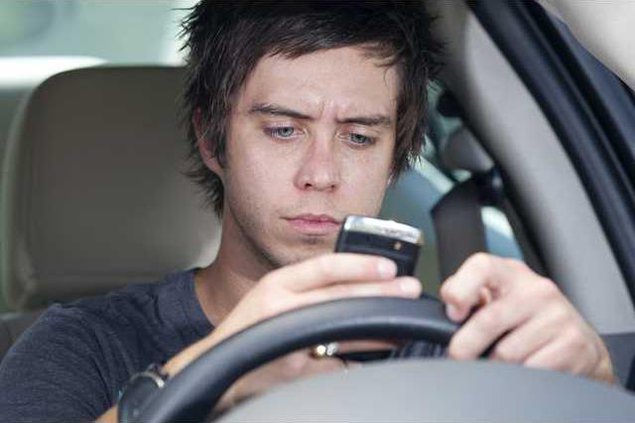If youre a parent of a teenage driver, youll probably admit that every time you see your child drive away, your stomach starts to knot up. And theres a pretty good reason why.
The National Center for Health Statistics states car crashes are the No. 1 cause of death for young adults age 15 to 20. Other studies indicate teenagers are far more likely to drive distractedly while texting or surfing the Web. In fact, according to a survey from AT&T, 43 percent of teenagers admitted to texting while driving, even though 97 percent of them said they knew texting while driving was hazardous.
Such staggering statistics are enough for any parent to lock away the car keys and rescind all driving privileges from their adolescents.
But there might be a better way. Rather than restricting driving privileges, new research suggests that you just ride with them.
Teens go from about 55 percent risky choice-making to about 45 percent when their mom is watching (their driving), said Eva Telzer, a professor of psychology at the University of Illinois.
Telzer recently led a study analyzing how a teens brain negotiates risk while driving. In the research, 14-year-old teenagers completed various simulated driving assignments while researchers charted the blood flow within their brains. In the first assignment, the subject drove solo; in the second test, the teens mother watched every move.
Telzer, along with Laurence Steinberg, a professor of psychology at Temple University, found that when teens drove alone they were more likely to make risky decisions, such as running a yellow light or driving too fast, than when they drove with a parent. These risky behaviors, the study noted, start within the evolving teenage brain.
Adolescence is not just a time of tremendous change in the brains structure, said Steinberg, it is also a time of important changes in how the brain works.
The study found that teenage drivers perceived risky behaviors to be rewarding. When a teen chose to speed through a light or drive recklessly, blood flow to the ventral striatum or reward center of the brain increased significantly.
Insert mom into the passenger seat, though, and the teen's brain performs differently.
When mom is there, the heightened ventral striatum activation during risky decisions goes away, said Telzer. Being risky, it appears, is no longer rewarding in the presence of mom.
The research brings a friendly reminder to parents everywhere: If you want your child to be a good driver, it starts with your example.
If you dont want your teen talking on a cellphone or eating while driving, dont do these things when your teen is riding with you, reads a State Farm handbook for parents of teenage drivers. Always buckle your seat belt before you start the car. Make sure youre not speeding or tailgating.
The National Center for Health Statistics states car crashes are the No. 1 cause of death for young adults age 15 to 20. Other studies indicate teenagers are far more likely to drive distractedly while texting or surfing the Web. In fact, according to a survey from AT&T, 43 percent of teenagers admitted to texting while driving, even though 97 percent of them said they knew texting while driving was hazardous.
Such staggering statistics are enough for any parent to lock away the car keys and rescind all driving privileges from their adolescents.
But there might be a better way. Rather than restricting driving privileges, new research suggests that you just ride with them.
Teens go from about 55 percent risky choice-making to about 45 percent when their mom is watching (their driving), said Eva Telzer, a professor of psychology at the University of Illinois.
Telzer recently led a study analyzing how a teens brain negotiates risk while driving. In the research, 14-year-old teenagers completed various simulated driving assignments while researchers charted the blood flow within their brains. In the first assignment, the subject drove solo; in the second test, the teens mother watched every move.
Telzer, along with Laurence Steinberg, a professor of psychology at Temple University, found that when teens drove alone they were more likely to make risky decisions, such as running a yellow light or driving too fast, than when they drove with a parent. These risky behaviors, the study noted, start within the evolving teenage brain.
Adolescence is not just a time of tremendous change in the brains structure, said Steinberg, it is also a time of important changes in how the brain works.
The study found that teenage drivers perceived risky behaviors to be rewarding. When a teen chose to speed through a light or drive recklessly, blood flow to the ventral striatum or reward center of the brain increased significantly.
Insert mom into the passenger seat, though, and the teen's brain performs differently.
When mom is there, the heightened ventral striatum activation during risky decisions goes away, said Telzer. Being risky, it appears, is no longer rewarding in the presence of mom.
The research brings a friendly reminder to parents everywhere: If you want your child to be a good driver, it starts with your example.
If you dont want your teen talking on a cellphone or eating while driving, dont do these things when your teen is riding with you, reads a State Farm handbook for parents of teenage drivers. Always buckle your seat belt before you start the car. Make sure youre not speeding or tailgating.





